How to make the most successful loaves in your bread machine
5 bread tips for home bakers.


Editor's note, June 2023: We've slightly updated this post, including photography, to provide even more guidance for readers. Time to get baking!
Do you bake bread in a bread machine?
Many bakers do, judging by the popularity of our bread machine recipes. And for good reason: The bread machine is a great way for first-time bread bakers to get started. And for seasoned bread bakers, it can be a welcome shortcut when you simply don't have time to bake bread the standard way: Simply pop ingredients into a machine like the Zojirushi Virtuoso and let it do all the work, from mixing to kneading to rising to baking.
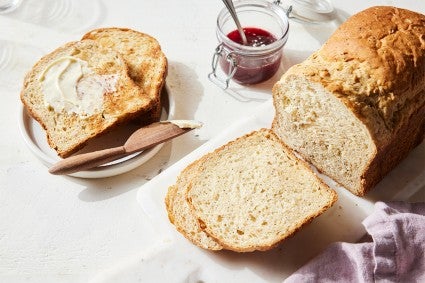
It would be great if the bread machine's chief product — sandwich loaves — would come out perfect every time. Beautifully risen, symmetrically domed, a lovely crust with no floury spots. But honestly? That's not the reality of bread machine baking. What you save in time and effort, you often lose in quality, including mishappen loaves or bread with those dreaded holes in the bottom from the bread machine's paddles.
But with just a minimal amount of effort, you can step in and help your bread machine as it kneads and shapes and bakes — thus ensuring yourself a higher percentage of perfect (or nearly so) loaves. You just need to be willing to touch the dough.
(Fair warning: If you're someone who likes to "set it and forget it" — add the ingredients, press Start, and come back 3 hours later — then this post isn't for you.)
Let's make some bread. We'll go with our most popular bread machine recipe: Bread Machine Bread — Easy As Can Be.
Begin by putting everything into the bucket of your bread machine. Putting the liquids in first makes the dough (and baked bread) less prone to floury spots.
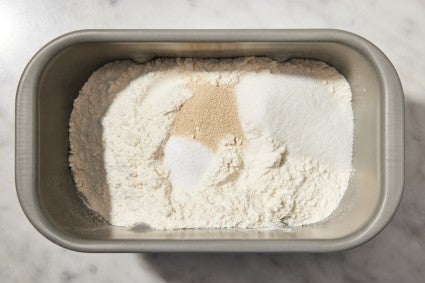
So many people seem afraid to "interfere" with their bread machine as it works. But honestly, nothing bad will happen if you open the lid and poke at the dough.
Start watching the dough about 10 minutes into its kneading cycle; it shouldn't be viscous and liquid-like, nor dry, stiff, and "gnarly." As fellow blogger Susan Reid says, "If you touch the dough and your finger comes back coated, the dough is too wet. If you touch the dough and it feels like poking a beach ball, it’s too dry."
The dough should have formed a cohesive unit and, if not "smooth as a baby's bottom" yet, should be headed in that direction. If it's not, add more flour (if it's too soft), or water (if it's dry).
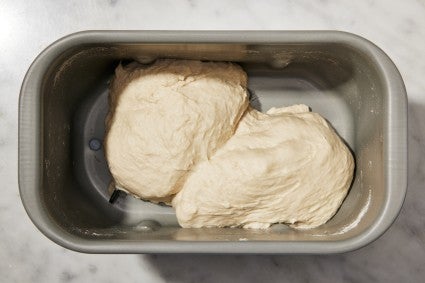

This step takes just a few seconds and will help prevent floury spots on the baked loaf's crust.
The timing for this can be a bit tricky; but once you figure it out, you're good to go forever.
Get out your kitchen timer, and put it in count-up (stopwatch) mode. Start your timer when you press "Start" on your bread machine (even if your machine has a "rest" or "preheat" mode right at the beginning); you're simply trying to gauge the amount of time between when you press start, and when the final rise begins.
You want to be around when your bread starts its final rise. Most bread machine manuals show a timeline of steps: e.g., preheat 31 minutes, knead 19 minutes, first rise 35 minutes, second rise 20 minutes, etc. A little simple arithmetic will give you an idea of when the final rise will start.
Hang around the kitchen when you figure that final rise is imminent. You'll hear the machine start up momentarily; it'll be knocking down the dough, which means the final rise is about to begin. When you hear that happen, stop your timer and check the time. (On our Zojirushi Virtuoso, it's 1 hour, 45 minutes).
So there you have it: You now know, for the next time you bake bread, that 1 hour, 45 minutes (or whatever) will elapse between the time you press "Start" and when the final rise begins. So whenever you make bread-machine bread and want to remove the paddles before the loaf bakes — pull out your timer and put it to good use.
Reach into the bucket, move the dough aside, and lift out the paddles.
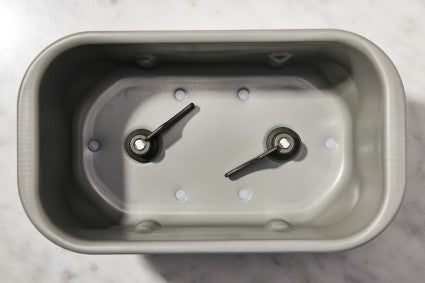
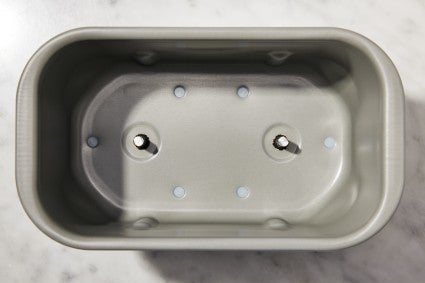
This step will result in loaves of bread without that noticeable divot at the bottom.
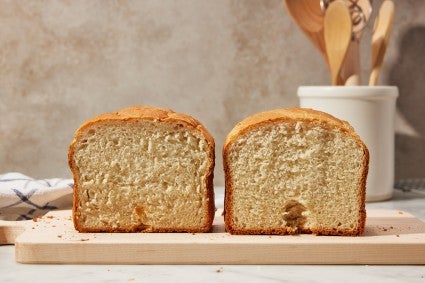
This is where you prevent ski-slope loaves — unevenly shaped bread that's much higher on one end than the other. When you open the lid of the machine to remove the bucket's paddles, check out the shape of the loaf. It might be just fine, filling the pan from end to end. Or it might look like this:
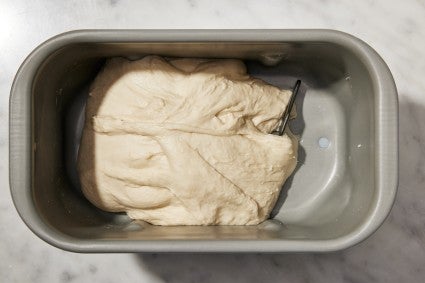
If the dough isn't in an acceptable loaf shape, take it out of the bucket, shape it into a nice, symmetrical log, and put it back into the bucket.
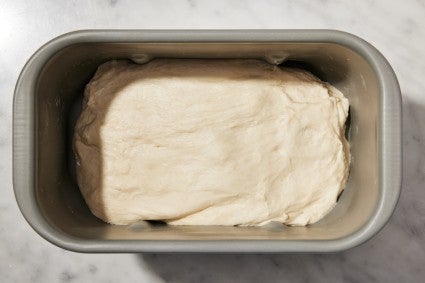
It will rise nice and evenly and bake into a lovely loaf.
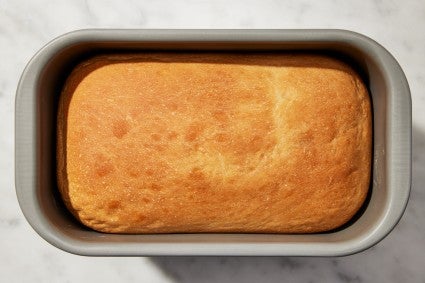
Isn't it annoying when you've done everything right, and your loaf still comes out looking ... well, not as good as it could?
You've pulled your gorgeous loaf out of the pan, and within minutes it develops a crust as wrinkled as Yoda. What's up with that? And how do you prevent it?
As soon as your bread is done, remove the bucket from the machine, take out the bread (which will be easy, since the paddles aren't there to impede its progress), and gently set the loaf back into the machine, sans bucket. Note: While setting the loaf back into the machine without its bucket is a reasonable option with our Zojirushi machines, it may not work well in other brands' machines. Let experience with your own machine be your guide here.
Crack the lid open an inch or so, and let the bread cool right in the turned-off machine. The still-warm (but gradually cooling) air helps prevent moisture from condensing on your loaf's surface — no wrinkles!
So, what's the baking science behind this? If your loaf hits the cooler air outside the machine, any moisture migrating from inside reaches the top surface and condenses, forming water droplets that cause the crust to shrink unevenly — in other words, to wrinkle.

Final step: Enjoy your wonderful homemade bread. Who says you can't bake a perfectly acceptable loaf right in your bread machine?
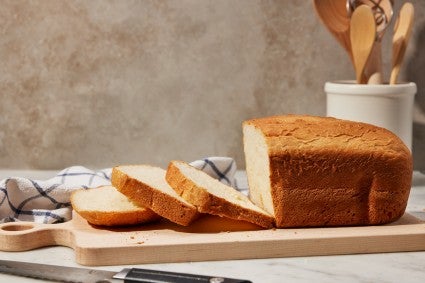
If you're looking for a great bread machine, our Zojirushi Home Bakery Virtuoso Plus Bread Machine has over 300 five-star reviews and is a beloved appliance for many King Arthur employee-owners.
Cover photo by Kristin Teig; food styling by Liz Neily.
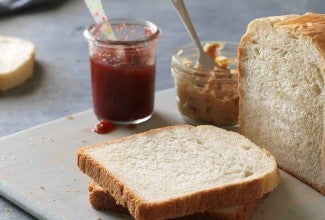


October 13, 2021 at 4:54pm
We have a Zojirushi Virtuoso. Not particularly liking the paddle marks in the bottom of the bread, we decided to try your suggestion of removing the paddles at the time of the second rise. It does stop the paddle marks, but the bread dough sticks to the top of the shafts and pulls out a round piece of bread when it is removed from the pan at the end of cooking. We’ve tried it three times now. The first time was when we found the tufts of stuck bread. The second time, I greased the shafts before putting the dough back in, hoping the bread would release without injury, but the result was the same. The third time I tried turning the “wings” on the bottom of the pan to try to loosen the bread before removing it from the pan. Nothing works. We still keep having round nickel-sized tufts of bread stuck to the tops of the shafts, leaving round voids in the loaves. Is there something else I can do to remedy this?
October 13, 2021 at 6:32pm
In reply to We have a Zojirushi Virtuoso… by Stacey (not verified)
Hi Stacy, a small hole will commonly still remain in the bottom of the loaves, as seen in the picture above step 4. We would grease the shafts with a vegetable shortening, most bakers will melt shortening and then use a small pastry brush to brush the shortening on. We hope this helps. Happy Baking!
March 5, 2022 at 2:53pm
In reply to We have a Zojirushi Virtuoso… by Stacey (not verified)
After the second rise/punch down, I take the dough out of the bread machine pan, shape it, put it in a regular loaf pan, and put that pan in the machine for the third rise and baking -- it sits perfectly on top of the pan supports/shafts. Works every time. Some people put the dough in the standard loaf pan and bake in the oven, but with the Zoji Virtuoso Plus it's not necessary since the standard pan fits in the machine like it's made for it.
March 6, 2022 at 9:38am
In reply to After the second rise/punch… by William (not verified)
Hi William, we haven't tried this method, and would recommend you consult Zojirushi to make sure this won't inadvertantly harm your machine or perhaps even cause a fire hazard.
September 25, 2022 at 8:26am
In reply to We have a Zojirushi Virtuoso… by Stacey (not verified)
This most likely voids the warranty but I’ve found success taking the bread out of the machine and baking it in the Zo V + machine in a Cuisinart non-stick 9” loaf bread pan instead of the Zoji bucket. This way you end up with a totally traditional loaf of bread. It’s a bit tricky to get the hot pan out at end of the cycle because there’s no nice handles and not a lot of clearance but I love not having a weird bread machine shaped loaf.
September 25, 2022 at 8:33am
In reply to We have a Zojirushi Virtuoso… by Stacey (not verified)
I should be clear I only use recipes for 1.5 lb or 1 lb loaves with the technique of baking with a regular loaf pan inside the Zoji V+, Definitely NOT 2lb or it’d be a mess.
July 26, 2021 at 9:48am
I am looking to do the opposite: I am hoping to give away my much loved bread machine (our new kitchen is nice but small!) but only if I can convert my favorite bread machine recipes to ones I can make by hand or stand mixer. Will I need to modify ingredients? Which bread pan size is better for the 1.5 lb loaves. Could I use the same pan for a 2 lb loaf or would 1/3 more dough spill out? For basic bread technique-- mixing, proofing times, shaping,--I'm thinking I might try Walter Sands' Basic White Bread recipe then experiment with other KAF bread recipes that have add-ins or use different flours. I'm hoping you might have some advice or can point to articles that might help. I might get off to a better start! I know it will be much trial and error. And thanks for your post! I have an old Kenmore bread machine and it has consistently made good bread for years and your post has me thinking I might have to reconsider carving out space for it!
July 26, 2021 at 1:45pm
In reply to I am looking to do the… by Maria (not verified)
It is great to know and understand both methods Maria! We suggest simply looking up the manual for your model bread machine and record the rise times and baking times. Kneading in a stand mixer generally takes about 5 to 7 minutes on a low speed, and the baking temperature is usually 350 degrees F. You may find that you need to extend the rise times just a touch on your counter because some bread machines have a pre-heat setting. But these tips will get you off to a good start! If you have questions about a specific or unusual recipe don't hesitate to reach out to our bakers for more support. We're available via email, chat and the phone seven days a week!
August 22, 2021 at 8:33am
In reply to It is great to know and… by mperry
I bought the smaller machine and didn't realize it doesn't make a full loaf- it works well for a 1# - I do take dough out during the add ingredients phase and reshape to my half loaf which is fine- I can't knead anymore so I really like this and the fact I'm only using a few ingredients
I made a 1# oatmeal bread + it's excellent
Next I'm trying rye
July 19, 2021 at 10:47am
Great Tips about too much water and taking out the paddles before the baking time!!
Pagination